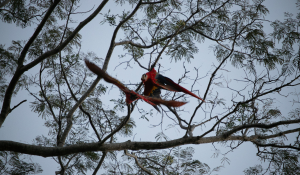Global Warming’s Impact on Biodiversity: How Companies Can Help?
Global warming is accelerating the destruction of biodiversity, threatening ecosystems, and destabilizing the natural balance. On average, natural ecosystems have diminished by 47% compared to their earliest recorded conditions. Specifically, the report highlights that approximately 75% of land areas have been significantly modified, 66% of oceans are facing rising cumulative pressures, and nearly half of coral reefs' live coral cover has disappeared.
As the Earth's temperature rises, the survival of countless species hangs in the balance. The biodiversity crisis, while driven primarily by human activity, can be mitigated through corporate responsibility. This article delves into the impact of global warming on biodiversity and how companies can contribute to its preservation.
Also check our article : Climate change and its impact on forests
The Human Land Use and its Role in Biodiversity
The main driver of biodiversity loss is human use of land, primarily for food production. Expanding agriculture, logging, and infrastructure development are transforming habitats at an alarming rate. Forests, wetlands, and grasslands are converted into cropland or urban areas, leaving little room for wildlife. Industrial-scale farming has caused fragmentation and destruction of habitats, which diminishes the capacity of ecosystems to support diverse species. This pattern is further exacerbated by the growing demand for food and resources as the global population increases.
The Effects of Climate Change on Ecosystems
In addition to habitat loss, climate change has altered marine, terrestrial, and freshwater ecosystems worldwide. Shifts in temperature and weather patterns, ocean acidification, and changing precipitation levels are transforming ecosystems faster than many species can adapt.
- Terrestrial ecosystems: In warmer climates, species migration to cooler regions is becoming common, but many animals cannot move fast enough to escape rising temperatures. This shift affects predator-prey relationships and disrupts ecosystems.
- Marine ecosystems: Warmer ocean temperatures lead to coral bleaching, a phenomenon where coral reefs, crucial marine habitats, expel the algae living within them and turn white. Without these algae, corals starve and die, severely disrupting marine biodiversity.
- Freshwater ecosystems: Changing rainfall patterns and melting ice caps alter river flows, causing droughts in some regions and flooding in others. Species that rely on consistent water sources face increasing survival challenges.

Consequences of Global Warming: Species Loss and Extinction
Global warming is driving species to extinction at an unprecedented rate. The loss of local species, increased prevalence of diseases, and mass mortality of plants and animals have been recorded in numerous regions. The first climate-driven extinctions are already a reality. For instance, the Bramble Cay melomys, a rodent species native to Australia, was declared extinct due to rising sea levels that destroyed its habitat.
Climate projections paint a bleak future for biodiversity:
- Animal migration and habitat loss: As temperatures rise, many species face the threat of losing their habitats. At +1.5°C, 4% of mammals could lose half their habitat, at +2°C, this figure rises to 8%, and at +3°C, 41% of mammals could face this fate.
- Coral reef degradation: Coral reefs, which are vital to marine life, are especially vulnerable. At +1.5°C, an estimated 70-90% of coral reefs could vanish, and at +2°C, the figure jumps to 99%. These losses would have a ripple effect on the entire marine food chain.
How Companies Can Help Preserve Biodiversity
While much of biodiversity loss is driven by large-scale land use and climate change, companies can play a critical role in reversing this trend. Corporations are significant users of resources, but they can also be stewards of sustainability by adopting biodiversity-friendly practices.
Introduction to Climate Contributions and the Management of Your Carbon Footprint
A carbon credit, in the voluntary carbon market (VCM), is a unit of measurement that represents one metric ton of CO₂ (tCO₂e) or the equivalent of another greenhouse gas (GHG) that has been reduced, avoided, or permanently removed from the atmosphere. It takes into account the Global Warming Potential (GWP) of various gases, translating them into CO₂ equivalents. For example, one ton of methane, with a GWP of 28, equals 28 tons of CO₂.
Through ClimateSeed's platform, businesses can calculate their emissions, select certified projects based on various typologies, and ensure their contributions are aligned with environmental and social impact goals. This approach helps organizations meet sustainability targets while contributing to global carbon reduction efforts.
Here are some key strategies on how corporations can adopt biodiversity-friendly practices:
1. Reduce and Better Manage your Land Footprint
Companies, particularly those involved in agriculture, construction, and resource extraction, should aim to minimize their impact on natural habitats. Strategies like precision agriculture, vertical farming, and sustainable forestry practices can limit the conversion of wild areas into developed land. Preserving and restoring ecosystems is vital for maintaining biodiversity.
2. Reduce Chemical Use and Eliminate Toxic Waste Streams
Industrial processes often involve chemicals that are harmful to wildlife. Pesticides, herbicides, and pollutants from manufacturing can degrade ecosystems. By reducing the use of harmful chemicals and eliminating toxic waste streams, companies can help maintain healthy ecosystems. Switching to organic or eco-friendly alternatives is an important step in this direction.
3. Contribute to Ecosystem Restoration
Corporate involvement in restoration projects can have a significant positive impact. Whether it's reforesting cleared land, restoring wetlands, or rehabilitating coral reefs, companies can contribute financially or participate directly in ecological restoration efforts. Ecosystem restoration not only enhances biodiversity but also helps mitigate climate change by sequestering carbon.
ClimateSeed supports restoration projects by connecting companies with high-impact, verified initiatives aimed at restoring ecosystems and reducing carbon emissions through reforestation and other conservation efforts. Contact us if you would be interested in supporting climate contribution projects.

4. Adopt Circular Solutions
The circular economy focuses on reducing waste, reusing materials, and recycling resources to minimize environmental impact. By adopting circular solutions, companies can help decrease their resource consumption and waste generation, which in turn reduces their impact on ecosystems. For example, using recycled materials instead of extracting new resources helps protect habitats from being disturbed.
5. Cultivate Biodiversity-Friendly Organizational Cultures
Corporate culture plays a key role in driving sustainable change. Companies should educate employees, stakeholders, and customers about the importance of biodiversity and encourage sustainable practices within the workplace. Embedding biodiversity into corporate strategies and goals can foster long-term commitment to conservation efforts. Check out our articles on what to expect from COP16, and how COP16 differs from COP29.
The accelerating impacts of global warming on biodiversity are stark and urgent. From the loss of animal habitats to the devastation of coral reefs, the world’s ecosystems are in peril. However, companies have the power to make a meaningful difference. By reducing land footprints, cutting down on chemical usage, contributing to restoration, embracing circular solutions, and promoting biodiversity-friendly cultures, businesses can play a vital role in preserving the planet's rich biodiversity. The path forward is challenging, but with concerted action, it is still possible to safeguard our natural world for future generations.
For more information, read our article on the rise of biodiversity credits.
Sources:
Common Q&As
At COP16, governments will need to review the state of implementation of the Kunming-Montreal Global Biodiversity Framework. The Parties to the Convention will need to show their alignment of the National Biodiversity Strategies and Action Plans (NBSAPs) with the Framework.
For more information, read our article: What to expect from COP16 UN Biodiversity Conference in Colombia?
Biodiversity credits are related to, but distinct from, voluntary carbon credits. While a carbon credit represents a tonne of carbon dioxide equivalent avoided or removed from the atmosphere, biodiversity credits represent units of biodiversity restored or preserved, which may have a variety of distinctive characteristics.
For more information, read our article:
The Rise of Biodiversity Credits: The Standards to Reach Nature Positive.
Both the Climate COP and Biodiversity COP serve as platforms to address two interconnected yet distinct global environmental challenges—climate change and biodiversity loss—both of which originated from the commitments made at the 1992 Rio Earth Summit.
For more information, read our article: Biodiversity COP: How does it differ from the Climate COP?
Share this
You May Also Like
These Related Stories

The Rise of Biodiversity Credits: The Standards to Reach Nature Positive

The COP16 UN Biodiversity Conference in Colombia explained


